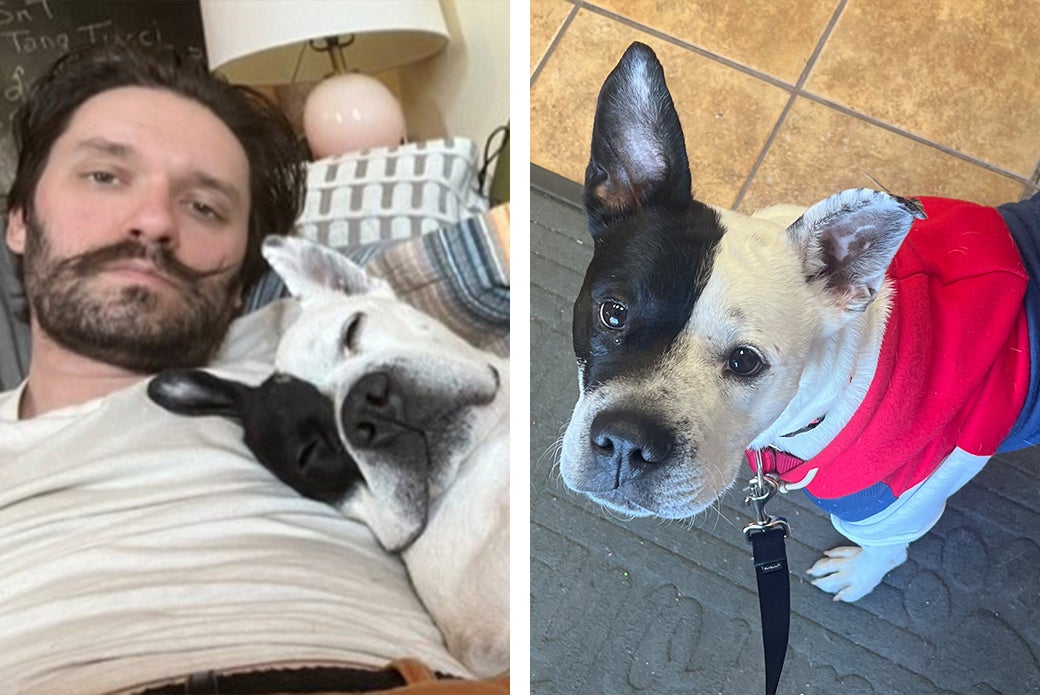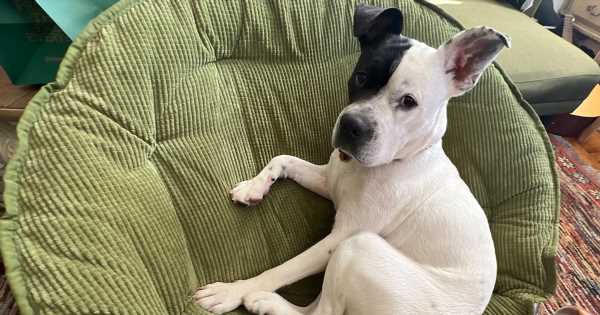

Andrew S. of Queens, New York, once walked dogs for friends and neighbors to gain experience before adopting one of his own.
“I have a dozen friends who have dogs, and the dog community in Astoria, where I live, is great,” says Andrew, who moved to New York City from Pittsburgh eight years ago. “I’ve always been jealous of the dog life.”
When Andrew—who has shared his home with a cat, Betty Boop, for the past five years—was ready to start looking for a dog, he visited the ASPCA website.
“My dream has always been to have a dog and cat snuggling me at the same time,” said Andrew.


“I inquired about another dog, but he had already been adopted,” Andrew says. “A few weeks later, a profile popped up for a dog named Nikolas. I thought, ‘Well, he’s a handsome guy,’ so I applied. Just listening to his story and what he’d been through, I thought we would be a good fit.”
A few days later, Andrew met Nikolas.
“The timing was right for us,” says Andrew. “He’s a great energy match for me. And I praise the ASPCA for giving him a second chance.”


Discovered In the Trash
Nikolas was reportedly discovered in a trash can in Jamaica, Queens, on November 17, 2022. The woman who found him called the police, and responding NYPD officers took Nikolas to the Veterinary Emergency Group, an ASPCA clinic partner. Two days later, Nikolas was transferred to the ASPCA. The criminal case remains open, and the investigation is ongoing.
Forensic Veterinarian Dr. Jasmine Bruno conducted his initial exam.
“He had an emaciated body condition—his ribs and spine were easily visible, and he exhibited a loss of fat and muscle mass,” says Dr. Bruno. Nikolas also had scabs on the tip of his tail, dermatitis on his scrotum, overgrown nails, a dirty, urine-stained coat, fleas and dental disease.


“Nikolas had low levels of vitamin B12 in his bloodstream and tissues,” says Dr. Sylvia Lesnikowski, Director of Internal Medicine and Clinic Research at the ASPCA Animal Hospital (AAH). “Dogs with low B12 levels can suffer from diarrhea, vomiting, loss of appetite, lethargy and weight loss.”
“His overall body condition was unhealthy,” adds Dr. Bruno. “Still, he was sweet and tolerated all handling.”
Becoming a Case Study
Nikolas was enrolled in an ongoing, prospective nutrition study conducted by the ASPCA Humane Law Enforcement (HLE), AAH and Animal Recovery Center (ARC) teams called Long Term Inadequate Nutrition (LTIN). Since June 2022, 24 dogs, including Nikolas, have been enrolled.
“We use the terminology ‘long-term inadequate nutrition’ because medically, we can show that is what the dog experienced,” says Dr. Robert Reisman, the ASPCA’s Supervisor of Forensic Sciences in NYC. “Besides the forensic medical investigation, the prosecutor will look at the law enforcement investigation and other evidence to decide how to prosecute the case.”
The LTIN study, which will eventually be published, will help people understand specifics about health abnormalities affecting dogs who have suffered from long-term inadequate nutrition and how emaciation affects multiple systems in the body.


“It will shed light on how to get them to a healthier body condition faster and learn what’s going on with their general health,” says Dr. Lesnikowski, who serves as Lead Investigator for the LTIN study. “By analyzing this data, we can make recommendations, streamline a more standardized approach and develop guidelines for handling animals that need this kind of extensive care.”


Most animals in the LTIN study, like Nikolas, are placed on a refeeding protocol to manage their transition from ‘survival metabolism’—using their body tissue for nutrition—to normal metabolism, in which food can be ingested and absorbed.
Nikolas qualified for the LTIN study because he had a body condition score of one to two out of nine (one being the thinnest and nine being the heaviest). Nikolas’ initial weight was just 26.4 lb.
“Refeeding protocol requires the direct care teams to follow precise feeding instructions and pay extra attention to the amount of food and treats they offer,” says Erica Barbot, Director, ARC. “Our team develops creative solutions for low- or zero-calorie edible enrichment options, like chicken broth ice pops. It’s a great example of our holistic approach to care and meeting the animals’ medical and behavioral needs.”


Just after Christmas, Nikolas was placed with a foster caregiver for several weeks. By the time he was adopted, he had gained 12 lb. and weighed nearly 40 lb.—an increase of 45% of his initial body weight.
Dreams Come True
“All the work the ASPCA did to prepare Nikolas for a full-time home paid off,” says Andrew, who renamed his new dog Ziggy. “Now he can shake, lie down, go in circles and dance. He learns so fast.”


Ziggy’s polaroid graces the walls at Tom’s Pet Supply, and he’s a regular at Château le Woof, a dog café, both in Astoria.
Ziggy and Andrew’s cousin’s French Bulldog, Parker, play well together. What’s more, Ziggy and Betty Boop have touched noses, and she’s gotten used to his presence. A project manager for an event company, Andrew mainly works from home, enabling him to help Ziggy work through occasional separation anxiety.


“We made his crate a safe space, and he goes in there with his sloth toy,” Andrew says. “He probably didn’t have a safe space before.”


A week after adopting Ziggy, Andrew emailed the Adoption Center to report, “Ziggy has adjusted so well to his Astoria life with Betty Boop and me. All three of us can already have nighttime TV snuggle time together. Yay! Dreams do come true.”


Source: Read Full Article



